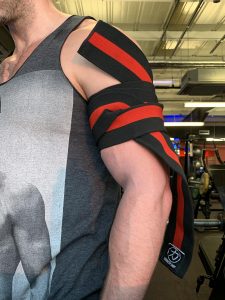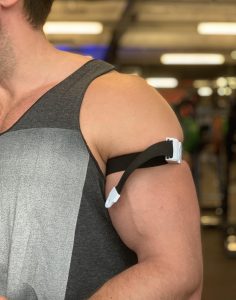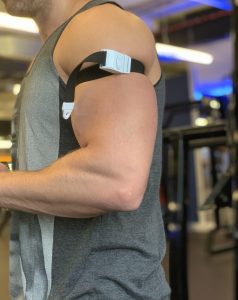Blood flow restriction training has been a topic of discussion over recent years. This is both within the exercise and pre/rehabilitation world. People use it in resistance training, cycling, and walking. People now recognise the benefits of blood flow restriction training not only in bodybuilding but also in rehabilitation.
What is Blood Flow Restriction Training?
Although its popularity has grown over recent years, the method of training has been around since the ’60s. Dr. Yoshiaki Sato first came up with the concept.
Blood flow restriction training is also known as occlusion training, or Kaatsu training (coined by Dr. Sato). In short and simple terms, it involves exercising with cuffs or tourniquets around the top of the limbs. This partially stops blood from travelling to the muscles. The restriction focuses on the blood coming back towards the heart, still allowing nutrient and oxygen-rich blood to enter the muscle.

Restricting blood flow in this way has various potential benefits. It’s associated with changes from a range if neural, endocrine, and metabolic pathways.
The Benefits of Blood Flow Restriction Training
Blood flow restriction training caught people’s attention for many reasons. It increases muscle mass, strength, and function. This is even achieved through cardio based exercise such as walking! It allows you to get similar results as heavy weight training, using much lighter loads.
For this reason, it’s used in bodybuilding but also in injury and medical rehabilitation. People who cannot necessarily lift heavy can still improve muscle function. In this way, blood flow restriction training is suitable for those who are older, at risk due to medical conditions or have suffered an injury.
Now we know the basics, let’s look deeper into how it works.
How Does Blood Flow Restriction Training Work?
The exact reasons why it works aren’t entirely known. There are several possible theories as to why the benefits of blood flow restriction training occur.
Pope et al. (2013) propose some of the possible mechanisms that cause adaptations:
1. Hypoxia of the muscles helps to recruit fast twitch muscle fibres further.
2. Longer periods of lactic acid build-up promote a systemic hormonal response
3. External pressure changes the contractile mechanics and muscle, resulting in an increase in cell signalling and growth factor expression.
4. Reduction in oxygen delivery creates further metabolic adaptations to the fast glycolytic system.
5. Production of reactive oxygen species, which help promote cardiac and skeletal muscle tissue growth
6. Removal of the bands forces reperfusion of oxygen back into the muscles. This induces swelling within the cells and stretches skeletal muscle structures, said to produce muscle growth.
7. Activation and proliferation of myogenic stem cells and myonuclei within the muscle fibres.
While there are many possible reasons for the benefits of blood flow restriction training, there is a lot of confusion. This is because of contradicting evidence and theories in different contexts. To keep things simple, we will focus on resistance training in this article.
Blood Flow Restriction and Resistance Training
Traditionally, to grow muscle using weight training, you’d need around 70% or more of your 1RM strength (ACSM, 2009). One of the benefits of blood flow restriction training is not needing to lift so heavy. It is consistently shown to have similar effects using only 20-30% of maximal load (Loenneke et al., 2009).

Different Cuff Sizes and Types
Different cuff sizes and pressures are often used. Following the research, cuff sizes have ranged from 5cm to 20.5cm in width, while cuff pressures have been between 50-240mmHg (Loenneke et al., 2011, Loenneke et al., 2012, Crenshaw et al., 1988). From the findings, it’s usually the case that as the cuff gets wider, you can lower the pressure.
Although most research uses pressurised cuffs, elasticated cuffs also work. Using elbow wraps or knee wraps, for instance, require less pressure than using medical tourniquets, which are much thinner in width.
Consistent or Intermittent Pressure
To get the benefits of blood flow restriction training, you need to apply pressure to the limb. This is either continuous or intermittent. As mentioned above, one of the possible reasons for muscle growth is reperfusion of blood into the muscle when you let it in. For this reason, there is debate around whether it is better to release pressure between rests or keep it on throughout the session.
Currently, research shows more benefits with continuous pressure throughout the exercise (Fahs et al., 2012, Neto et al., 2016). However, you should release of the cuffs between different exercises.
Who Should Use Blood Flow Restriction Training?
To improve muscle function and size, this type of training is safe and effective if done correctly. However, if fit and healthy, this is not a training method that everyone “should’ do. For a healthy individual, the benefits of blood flow restriction training are similar to lifting heavy weights. So using it is really a matter of preference.
This said, here are some situations where the benefits of blood flow restriction training are especially useful.

Recovering from Injury
Blood flow restriction is a useful method of exercise while you are recovering from an injury. In clinical settings, it helps actively rehabilitate injured muscles. For serious injuries, see a qualified professional before starting any rehab programme.
Taking a Break from Lifting Heavy
Sometimes you need to step back from loading heavy weights through the body. They can take a significant toll on your joints. One of the benefits of blood flow restriction training is to get you similar results to heavy lifting, but using lighter weights.
Adding Variety
Using this type of training helps you switch things up and add variety. Generally, variety and progression are two of the most important factors for improvement. Add blood flow restriction training if you are a bit lost for options or just want something different.
Important Factors to Be Aware Of
The benefits of blood flow restriction training sound great. Bigger, stronger muscles with better function, without the heavy weight! But there are some vital factors you need to consider before you start.
This said, however, there are some vital factors you need to consider if you are thinking of using the method.
Medical Conditions
As we’ve covered, research shows many benefits of blood flow restriction training. But there are still factors which aren’t fully understood. For example, some people have concerns regarding the risk of blood clots. However, over time, evidence shows that there is minimal risk associated with it. It is now deemed a safe and effective tool, even for rehabilitation in clinical settings (Vanwye et al. 2017).
Despite this, people are still unsure of the impact of blood flow restriction training on the heart and blood pressure. So if you have any conditions that affect either of these, you should first contact someone that specialises in it.
While the benefits of blood flow restriction training suit many people, some should definitely avoid it. People with certain medical conditions should not use this type of training. This is either due to unknown risk factors or due to the necessity of a professional to oversee it. If this interests you, you can find this list here.
The Importance of Pressure
Overall, in a healthy person, the leading risk factor for this is the cuff itself. The width and pressure of the cuff are important. The cuff should not be too tight. If the cuff fits too tightly, it could cause peripheral nerve compression (Nakajima et al. 2006).
If you don’t have access to pressurised cuffs, it can be hard to gauge how tight they should be. It can take a little practice and reading around the research to get this right. Most studies measure pressure using millimetres of mercury, which is the same method used when you get your blood pressure done.

This is a precise measurement, but with elasticated bands, its more of a best guess. One way to know whether the pressure is too tight is to pay attention to your pulse. You should still feel a pulse within the distal end of the limb (wrist or ankle).
If using your arm, ensure you can feel a pulse at your wrist. Place two fingers between the bone and tendon underneath your thumb, which is where your radial artery is. For legs, you can use the pulse on the top of the foot. Take three fingers from the opposite hand and place them over the bony area of the foot.
Comfort When Exercising
To get the benefits of blood flow restriction training, comfort is essential. Cuff size, pressure, and exercise protocol are factors to be aware of. Restricted blood flow can feel uncomfortable around the muscle, and even painful for some. This differs based on how strong the pressure is. It also depends on the width around the muscle for each individual. So, whichever width you start on, begin with light pressure. At first, stick to basic exercises to see how you manage.
The Right Kit
When it comes to kit, it doesn’t need to be expensive. Medical tourniquets from Amazon work great for my arms. Simple knee wraps around the top of my thighs are great for legs. Both of relatively cheap and easy to find.
The Right Weight
Due to the light loads, this type of training isn’t suited to those who like to lift heavy. It’s essential to understand it’s supposed to be light, and not to try to increase the weight too much.
You should stick within 20-50% of max strength. You’ll most likely find the load easy, to begin with. This sometimes leads people to bump up their numbers to quickly. If you do this, then you will increase your risk of injury. For example, with compound exercises like squats or bench, you might fatigue earlier (it can come on suddenly). Trying to force finish a rep can be dangerous. So, if you prefer lifting heavy, this type of training isn’t for you.
If you don’t mind lifting light (or the odd question about why you have cuffs on your limbs), give it a go! Below we will cover the basics of how to get started.

How To Begin Blood Flow Restriction Training
So, you now know the benefits of blood flow restriction training and who it works for. Here is a helpful summary to get you started.
- 1Pressure is important. As a rule of thumb, you should be able to feel a pulse in the distal parts of the limb. Check beforehand, so you know what to feel for. If you can’t feel your pulse once the bands are on, the pressure it too tight.
- The width of the band determines the pressure needed. The wider the band, the lower the pressure.
- Focus on high reps and short rests, using low volume (20-50% of 1RM).
- A rough guide for training is 3-4 sets with reps of 15+ on each exercise. Rest for 30-60 seconds in between. For example, 1 set of 30 reps, then 3 sets of 15 reps with 30 seconds rest for each set.
- Aim to use blood flow restriction 2-3 times per muscle group per week, although this is a rough guideline! Type of training and intensity can alter this quite a bit. For example, very low-intensity exercise like walking is perfectly safe to do twice a day for multiple days a week. (Pope et al., 2013).
Further Reading
If you’re aiming for muscle gain, nutrition is important! Read up on how to eat to gain muscle here. It’s essential you’re training in the right way. Learn more about the key elements of muscle gain workout plans and how to create one here.
